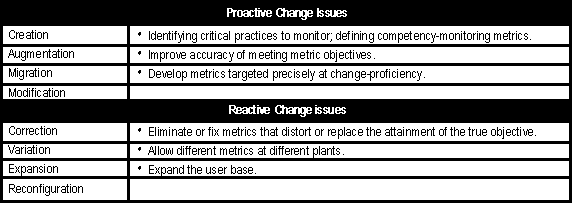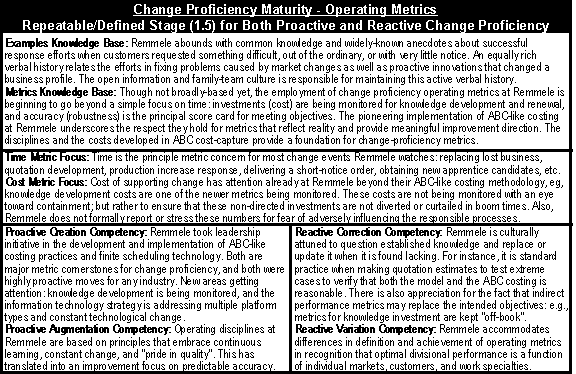Identifying critical practices to monitor; defining
competency-monitoring metrics
- It is common today for manufacturers who are trying to reduce costs in
order to become more competitive to monitor process times for such things as change-over,
set-up times, and die-change and to set goals for improvement. In general, it is even more
common for companies to focus on cycle-time reduction in what they consider to be their
current critical competitive practices and to set specific improvement objectives,
especially in product development and product realization. Our interest in this reference
model is specifically focused on change proficiency and related critical business
practices. Outside of standard production process operating variables neither Remmele nor
the machining industry yet focus overtly on change proficiency as a critical competitive
practice across the board. Nevertheless, Remmele has laid some valuable groundwork with
its early ABC implementation for costing and its informal monitoring of training and
knowledge development (to ensure they maintain enough), quotation times, time taken to
re-employ surplused capacity, and on-time deliveries. Though these activities are
considered critical and are the subject of management review and discussion, their
measurement remains informal for fear that hard display and monitoring will distort the
actual practice.
- When the metrics for on-time delivery performance indicated room for
improvement many years ago, Remmele took the initiative and developed finite production
scheduling capabilities. They continue to monitor on-time delivery for each plant.
- Quotation time is watched principally because the Remmele quotation
process is a highly detailed and consequently time-consuming activity. Cognizance of this
metric through informal monitoring has supported the development of semi-automatic
quotation assistance tools. It takes about six weeks to make a Plant 30
firm–fixed-price quotation for a focused-factory project that will make a commitment
for years. Generally they will begin researching process possibilities well in advance of
the RFQ in order to develop a working knowledge base.
- Recently Remmele mounted a full-court press to find new business that
could absorb personnel idled by an outsourcing contract that moved offshore. This division
had grown principally in response to unsolicited opportunities and without the need for an
aggressive business development capability. Though the experience resulted in five new
contracts, the protracted time and uncertainty involved in the period of prospecting and
negotiation for additional outsourcing contracts sensitized them to this process. An
informal metric is now in place to gauge response time improvement when the next reaction
event is required.
- ABC-like practice at Remmele is used both as an improvement yardstick and
as a foundation for automating quotation assistance. In general, ABC practices are a
strong and necessary enabler for change proficiency as
- robustness requires predictable costs. At the same time, ABC-like
measurements are the only direct way to actually measure the cost of change. "We
don't have a full ABC implemented, but Peat Marwick estimates that we are about 75% there.
Years ago when customers wanted to analyze the costs of their products, Remmele had to
justify allocations of square feet, machine, lights, etc., and Remmele plants needed to
know how to make real money so they could buy some more equipment." That's the
motivation Remmele cites for their implementation of costing concepts years before ABC
gave credence to the practice. The company has always kept the "value" on
equipment that was established during the depreciation period, even after full
depreciation has occurred. They allocate factory burden and SG&A costs according to
machine hours and people hours. Standard rates are calculated for 80% of full plant
capacity and updated annually. Machine hours are in the allocation scheme to eliminate
artificial pressure to remove people and automate fully. If work disappears from the shop
or plant capacity is underutilized, the rates are not changed; rates are based on
"standard plant capacity" and not on actual plant usage. They strive to do as
much "direct" costing as possible, for example:
- The Repetitive Batch Division charges costs of quality people directly.
"We did more wrap-rate roll-ups until technology became a major factor. Pulling
people out with burdened labor only really caused a problem."
- Job quotations from Plant 30 show direct costs for: engineers (including
quality), engineering technicians, tooling, and square footage allocation for occupancy.
All are direct charges and not buried in the allocated overhead rate.
- At the Automation Division: "We want 90% direct engineering
charge-off and 80% direct technician charge-off from a 40-hour week. But we actually
average a much higher work week in order to accomplish training."
Improving accuracy of meeting metric objectives
- As a general metric improvement policy, Remmele focuses on attainment
accuracy. Thus, actuals vs. committed objectives are monitored for the usual operating
metrics, with awards given for accuracy and generally not for doing better than the
objective. This operating philosophy is not yet predominant in the change proficiency
operating metric practice only because most are still in the informal stage.
Developing new metrics targeted precisely at change proficiency
- Successful quotation development, engineering change incorporation,
process development and installation, production-rate doubling, single part
quotation-delivery cycle, corporate-wide change of divisional performance-reporting
system, and other such change proficiency issues will become critical with time. Remmele
has just decided to try to monitor the amount of knowledge development conducted each year
by the company, knowing that this change proficiency cornerstone practice feeds its
competitive leadership ability to enter new markets and apply new technologies
effectively.
Eliminating or fixing metrics that distort or replace the attainment
of the true objective
- Management theorists have long told us that we generally won't get
performance by simply setting objectives, but that we must measure and display the
progress and attainment as well. However, that old warning "be careful what you wish
for" is highly applicable when it comes to operating metrics and well regarded at
Remmele. Just as counting strokes per day as a figure of merit for a stamping plant
increases the stroke count without increasing the finished parts count, so will measuring
the hours or dollars invested in training divert the focus away from valuable and high
quality knowledge development. Remmele management understands this phenomenon and has
chosen explicitly to exclude training and knowledge-development measurements from
operating reports and management incentive programs—though they have started
an off-book metric to insure that this critical knowledge-development practice isn't short
changed in boom cycles.
- At a meeting with divisional controllers: "Accountants here just
keep score; we don’t run the place. That’s different here, and we like it that
way."
Allowing different metrics for different plants
- Change-proficient processing for repetitive batch operations have
different key factors than those for production machining or even general machining
divisions, not to mention custom automation development and fabrication. One division may
be especially concerned about set-up times and short-lead-time orders, another with
constant cost reduction and production rate changes, a third with team learning curves and
quotation development time, while a fourth frets over some of the same as well as some
others. All need the
- ability to custom design and fit their operating metrics, and all benefit
from seeing the achievements possible with different approaches. Though Remmele has some
universal performance metrics in the financial arena, even there they understand that
different markets and operating realities will have differing optimal performance levels.
Expanding the user base
- At this early informal stage of change proficiency operating metrics, the
management team is responsible for definition, review, and evolution. When the competency
and progress of change proficiency at Remmele requires explicit and broader involvement,
the open-communication, dissemination, and buy-in practices and vehicles within the
company will facilitate the introduction and utilization of metrics.
|
 Paradigm Shift
Paradigm Shift Paradigm Shift
Paradigm Shift
